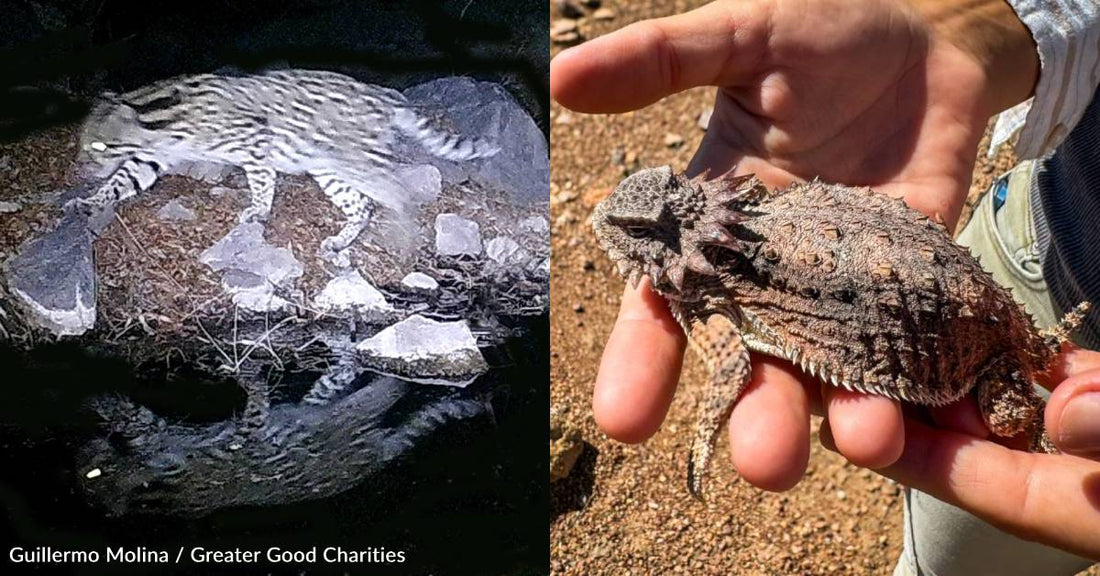Ocelots, Horned Lizards, Even Ants: You Helped Scientists Study Them All in Mexico
Michelle Milliken
As our planet faces an extinction crisis, it’s more important now than ever to study areas with rich biodiversity. Survey work like this helps us understand and ultimately protect the species that live in these regions. Last year, you helped us continue this work in a unique mountain oasis surrounded by desert.
The Madrean Sky Islands are made up of mountain “islands” that rise up between desert and grasslands in the southwestern U.S. and northwestern Mexico. This region connects the subtropical Sierra Madre Occidental range in Mexico and the temperate Rocky Mountains further north. It’s also surrounded by the Sonoran and Chihuahuan deserts. Meeting in the midst of such varied landscapes has made the Sky Islands rich in biodiversity. They’re home to more than 7,000 plant and animal species, including more than half of North American birds.

To help safeguard this unique area, we've worked with our partner Greater Good Charities to send survey groups there as part of GGC’s Global Discovery Expeditions program. The program is dedicated to exploring, studying, and protecting threatened biodiversity hotspots by providing the first step in conservation: the observation and recording of an ecosystem’s species. These records are added to a publicly viewable database for other researchers to access.
Last year, Global Discovery Expeditions visited the Sky Islands in the spring and the fall, aiming to add more records and build upon the years of work they’ve dedicated to the region.
Spring Trip
In April, a team headed just outside Banámichi in the Mexican state of Sonora, partnering with Zoo Miami for the trip. The 22-member group consisted of Mexican and American scientists, including those with expertise in ornithology, herpetology, lepidopterology (the study of moths and butterflies), and botany. There were also photographers. This location was chosen to help fill gaps in the database because they hadn’t done surveys there before.
To help document species on this trip, the group made use of game cameras, which caught animals including a mountain lion, a ringtail, and an ocelot. Though it wasn’t captured on the cameras, a jaguar was also confirmed to be in the area.

A three-year study of the rock horned, or Ditmars horned, lizard was also coming to an end for this group, and they took the chance to explore the area to look for more. They came across two, marking the first time the species had been found in this particular area.
Throughout this trip, the group also recorded three frog/toad species, four lizard species, a turtle species, three snake species, and 77 bird species. They had 550 plant records, as well, which were observations not species.
Fall Trip
In September, scientists were back at it, this time in Sierra San Diego, outside of Bavispe in Sonora. This trip was made in partnership with Zoo Miami and CONAP, the National Council for Protected Areas. In all, 22 U.S.-based scientists and 11 Mexico-based scientists took part.

The group also included an Arizona State University myrmecologist, or someone who studies ants. He extended the ranges of five ant species into this region of Sonora.
The trip marked the first time they’d used new auditory survey techniques, thanks to Dr. Frank Ridgley from Zoo Miami. This helped them collect and analyze more than 6,700 calls.

In all, the trip also led to 257 new animal records for the database, including 16 mammal species, 12 bat species, 112 bird species, 18 reptile species, and 109 insect species. The team said more would be added as they were identified by the specialist.
You’ve Contributed to This Important Research
With your clicks, trivia participation, shopping for a cause, and direct donations, these Global Discovery Expedition trips continue to document species in not only the Madrean Sky Islands, but also in other biodiversity hot spots, including in Vietnam. If you’d like to continue to support these expeditions, learn how here!
For more pictures of the species recorded during 2024’s Mexico trips, keep scrolling!











